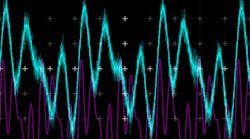Digital Techniques Enhance Doherty Amplifier Efficiency
Doherty amplifiers are widely employed in cellular base stations and other wireless communications systems. Typically, they consist of two parallel amplifiers—one biased for Class AB operation (the carrier amplifier) and the other for Class C bias operation (the peaking amplifier)—along with power splitters and combiners to divide input signals, and then recombine them at the outputs of the two amplifiers.
Though simple in design, these amplifiers suffer from inefficiency due to the different bias schemes for the two amplifier sections. Digital methods have been applied to improve the efficiency, including synthesizing a digitally controlled signal-distribution profile that adaptively distributes the input power between the two amplifiers for less wasted power. Other approaches have involved the use of dual input ports to attempt to drive the two amplifiers closer to saturation and at higher gain levels.
A concern with all efficiency-enhancement methods applied to Doherty power amplifiers is the compromise in linearity due to phase offsets in the signal paths. But as reported by a trio of Canadian authors from the University of Calgary, linearity can be improved while also enhancing efficiency by using some straightforward techniques, including carefully choosing the electrical length of the series transmission lines at the inputs of the two amplifier sections. The phase mismatches in these input transmission lines can result both in nonlinear performance and loss of power and efficiency.
To overcome these performance limitations, the authors developed a demonstrator prototype amplifier that uses a power-indexed lookup table for dynamic phase alignment between the carrier and the peaking amplifiers in a Doherty amplifier. The open-loop approach is executed by applying digital predistortion (DPD) at the input of the peaking amplifier signal path. With DPD, the amplitude-modulation/phase-modulation (AM/PM) response of the peaking amplifier becomes relatively constant. Therefore, any residual phase differences between the two transmission-line paths can be corrected by adding a constant phase shift at the input of the phase-lagging signal path.
The researchers reviewed various Doherty amplifier efficiency-enhancement approaches and found that the adaptive power-distribution approach was suitable for improving efficiency for both narrowband and wideband signal applications. They concluded that with improved and affordable digital-signal-processing (DSP) components, the use of digital techniques can improve output power by as much as 2 dB, and efficiency up to 20%.
See “Doherty Goes Digital,” IEEE Microwave Magazine, Vol. 17, No. 8, August 2016, p. 41.

